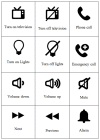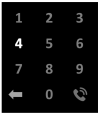A Symbols Based BCI Paradigm for Intelligent Home Control Using P300 Event-Related Potentials
- PMID: 36560369
- PMCID: PMC9781197
- DOI: 10.3390/s222410000
A Symbols Based BCI Paradigm for Intelligent Home Control Using P300 Event-Related Potentials
Abstract
Brain-Computer Interface (BCI) is a technique that allows the disabled to interact with a computer directly from their brain. P300 Event-Related Potentials (ERP) of the brain have widely been used in several applications of the BCIs such as character spelling, word typing, wheelchair control for the disabled, neurorehabilitation, and smart home control. Most of the work done for smart home control relies on an image flashing paradigm where six images are flashed randomly, and the users can select one of the images to control an object of interest. The shortcoming of such a scheme is that the users have only six commands available in a smart home to control. This article presents a symbol-based P300-BCI paradigm for controlling home appliances. The proposed paradigm comprises of a 12-symbols, from which users can choose one to represent their desired command in a smart home. The proposed paradigm allows users to control multiple home appliances from signals generated by the brain. The proposed paradigm also allows the users to make phone calls in a smart home environment. We put our smart home control system to the test with ten healthy volunteers, and the findings show that the proposed system can effectively operate home appliances through BCI. Using the random forest classifier, our participants had an average accuracy of 92.25 percent in controlling the home devices. As compared to the previous studies on the smart home control BCIs, the proposed paradigm gives the users more degree of freedom, and the users are not only able to control several home appliances but also have an option to dial a phone number and make a call inside the smart home. The proposed symbols-based smart home paradigm, along with the option of making a phone call, can effectively be used for controlling home through signals of the brain, as demonstrated by the results.
Keywords: EEG; P300; brain-computer interface; event-related potentials; phone control; smart home.
Conflict of interest statement
The authors declare no conflict of interest.
Figures










References
-
- Laureys S., Pellas F., van Eeckhout P., Ghorbel S., Schnakers C., Perrin F., Berré J., Faymonville M.E., Pantke K.H., Damas F., et al. The Locked-in Syndrome: What Is It like to Be Conscious but Paralyzed and Voiceless? Prog. Brain Res. 2005;150:495–611. doi: 10.1016/S0079-6123(05)50034-7. - DOI - PubMed
MeSH terms
Substances
Grants and funding
LinkOut - more resources
Full Text Sources
Research Materials
Miscellaneous

